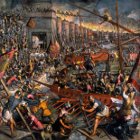In this map layer, primary parties and secondary parties to violent conflicts are distinguished and depicted for the year 2017.
Primary parties, both state-based and non-state are responsible for the violent conflicts outbreak over an Incompatibility. State-based and non-state secondary parties on the other hand are supporting one of the primary parties financially, military, with logistics or with battle participation. Therefor secondary parties to violent conflicts can be distinguished into warring and non-warring parties.
A conflict can develop into a violent conflict and even a war. There are various criteria that help differentiate conflict from war. One of these criteria is a quantification of the number of victims of war, or the determination of certain features of conflict. This module is based on a definition of war where only wars or conflicts are taken into account in which at least one state is party to the conflict and in which more than 25 persons have been killed due to fighting. It also differentiates between four categories of war/violent conflict: extra-state/-systemic violent conflict (state against non-state actors beyond existing borders) inter-state (between two states), intra-state ( state against non-state actor within existing borders) and internationalised intra-state conflicts (state aided by other states against non-state actor within existing borders).






